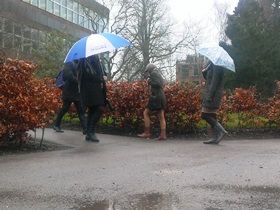The Met Office confirmed this morning that 2012 was the wettest year on record for England, and the second wettest ever for the UK as a whole. Dr Roger Brugge, from the University of Reading’s Department of Meteorology, analyses the weather records from the University’s own climatalogical station during 2012.
2012 was a year in which precipitation and its impacts were uppermost in the minds of most people. With 821 mm of rain falling at the University of Reading, it was the wettest year since 2000 when 852 mm fell. The only other wetter years since 1917 at the university were in 1951 (when 896 mm fell), 1927 (858 mm) and 1960 (with 841 mm).
In Reading the year began with three dry months, with May also being on the dry side. Worthy of note in March were the 23rd and 24th (when 20.1°C was reached each day) and the 28th (when 21.4°C was recorded). The latter date came close to passing the highest March temperature on record at the University in 1965, when 22.8°C was recorded. Both January and March average 1 degC above normal – they were the only months of 2012 that could be said to be much warmer than normal.
April brought the imposition of hosepipe bans – whereupon it promptly turned wet with 120 mm of rain falling in the month, making it the wettest April locally since 2000. This was followed by a dry May – the eleventh dry month since the beginning of March 2011. With more days reaching 25°C in May than in any other May over the past 50 years hopes were beginning to build of a good summer, albeit with drought restrictions.
But it was not to be. June turned wet with 123 mm of rain falling, making it the wettest June in the town since 1971 with the longest rainless spell lasting just two days. In fact all the cloud in June made it duller than March. But at least by early July all hosepipe bans had been lifted.
July was quite cool and also wetter than average although August was slightly drier than normal. But, again, the perception was of a poor, dull summer. August, despite temperatures being close to average, was the sunniest month of 2012 (with 193 hours of sunshine) – meaning that 2012 was the first year locally since 1988 in which no month recorded 200 hours of sunshine. So maybe impressions were right?
September brought close to normal rainfall amounts, but the final three months of 2012 were wet – with local flooding, especially in December as rain continued to fall on saturated ground. With both October and December recording over 100 mm of rain (with 128 mm October was the wettest month of the year) Reading experienced four months in 2012 reaching this mark – the first time this has happened for at least 95 years.
Early December brought a hint of winter when the maximum temperature on the 12th being just -1.6°C, the coldest December day since 1991.
Overall, temperatures were slightly lower than normal (by 0.2 degC) making it the coldest year since 2010 (which was 0.7 degC colder). Sunshine totals came out at just above average – largely thanks to the sunny months of March and September.
- Highlights of the weather in 2012:
- 821 mm of rain made it the wettest year since 2000 when 852 mm fell.
- The only other wetter years since 1917 at the university were in 1951 (896 mm), 1927 (858 mm) and 1960 (841 mm).
- 21.4°C on 28 March was close to the highest March temperature on record at the University (22.8°C in 1965).
- April was the wettest April locally since 2000.
- May was the eleventh dry month since the beginning of March 2011.
- June was the wettest June in the town since 1971. June was duller than March this year.
- 2012 was the first year locally since 1988 in which no month recorded 200 hours of sunshine.
- The final three months of 2012 were wet with local flooding.
- There were four months during 2012 when over 100 mm of rain fell, the first time this has happened locally for at least 95 years.
- The maximum temperature of -1.6°C on 12 December made this the coldest December day since 1991.
- Overall, temperatures were slightly lower than normal (by 0.2 degC) making it the coldest year since 2010 (which was 0.7 degC colder).
- Sunshine totals came out at just above average – largely thanks to the sunny months of March and September.
This summary of the weather of 2012, produced by Roger Brugge and Mike Stroud, is based on daily observations made at the University of Reading climatological station. For more details on the observations of 2012 contact r.brugge@reading.ac.uk.

